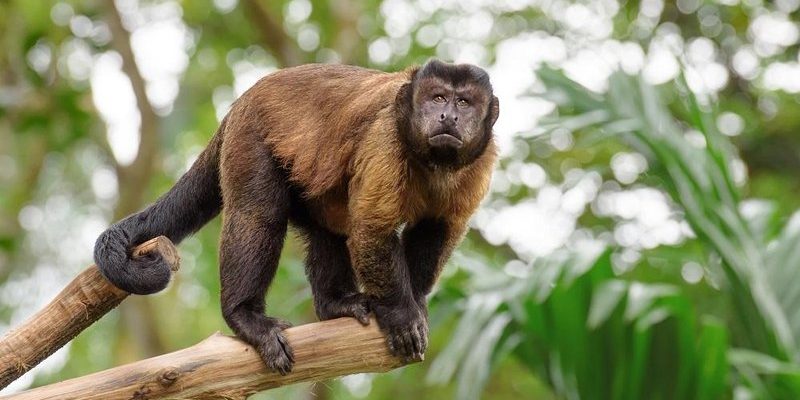![Comparing The Tufted Capuchin Vs. [Similar Species]](https://gudri.com/wp-content/uploads/2025/06/Comparing_The_Tufted_Capuchin_Vs___Similar_Species__image_0.jpg)
So, if you’re curious about what sets the tufted capuchin apart from its brown counterpart, you’re in the right place! In this article, we’ll dive into their habitats, behaviors, physical traits, and some interesting facts that show why these monkeys are worthy of our attention.
Where Do They Live?
Both the tufted capuchin and the brown capuchin are native to Central and South America, but they prefer slightly different environments. The tufted capuchin typically hangs out in tropical forests, often in higher elevations. They thrive in canopies where they can leap from branch to branch. Imagine them as little acrobats, swinging effortlessly through the trees.
On the other hand, the brown capuchin prefers a more diverse range of habitats. You’ll find them in secondary forests, savannas, and even some coastal areas. They’re a bit more adaptable when it comes to their living conditions. Think of them as the “survivors” of the monkey world, able to settle in a variety of environments.
Habitat Range Compared
To give you a clearer picture, here’s a quick comparison:
| Species | Preferred Habitat |
|---|---|
| Tufted Capuchin | Tropical forests, often at higher elevations |
| Brown Capuchin | Diverse habitats, including savannas and coastal areas |
You might wonder how their habitats influence their lifestyles. The tufted capuchin’s preference for dense forests means they tend to be more arboreal, while the brown capuchin’s adaptability allows them to forage on the ground more often.
Physical Traits and Appearance
Let’s talk about looks! The tufted capuchin is easily recognizable due to its distinctive tufted hair on top of its head. It has a mix of dark and light fur, giving it a somewhat sophisticated appearance. Imagine a fashion-forward friend who always has a chic hairstyle—that’s the tufted capuchin for you!
In contrast, the brown capuchin sports a lighter coat, often in shades of brown or tan. Their fur is less textured, which gives them a smoother appearance overall. Think of them as the laid-back cousin who prefers comfort over style.
Size Difference
When it comes to size, there’s a slight difference. Generally, tufted capuchins are a bit larger, averaging around 3–4 feet long, while brown capuchins usually stay around 2–3 feet. It’s like comparing your tall friend to someone who’s a bit shorter but equally fun!
Behavior Patterns
Both species are known for their intelligence, but they have different social behaviors. Tufted capuchins tend to be more social and often live in larger groups, which fosters a strong sense of community. They love to play and groom each other. It’s kind of like a family reunion where everyone is catching up and sharing stories!
On the flip side, the brown capuchin is a little more independent. They can form smaller groups and sometimes go off on their own foraging adventures. Picture a group of friends where one just prefers to explore solo for a bit—that’s the brown capuchin.
Foraging Behavior
In terms of foraging, tufted capuchins have impressive problem-solving skills. They’ll use tools—like stones—to crack open nuts. It’s like watching a clever child figure out how to use a toy to get a treat. Meanwhile, brown capuchins also show some tool use but rely more on their agility and cleverness to find food in dense foliage.
Communication Styles
How do these monkeys communicate? Both species use a mix of vocalizations, body language, and facial expressions to convey messages. The tufted capuchin is known for its loud calls and expressive gestures. When they see something exciting—like a tasty snack—they’re quick to share the news!
On the other hand, the brown capuchin has a more varied set of sounds. They might whistle, grunt, or even bark, depending on the situation. It’s like a whole different language!
Observing Communication
If you were to spend a day watching these monkeys, you’d quickly notice their unique styles. The tufted capuchins might be more vocal, creating a lively atmosphere, while the brown capuchins might be more subtle, communicating through a mix of soft sounds and body movements.
Conservation Status
Unfortunately, both species face threats from habitat loss due to deforestation and human activities. The tufted capuchin is classified as “Vulnerable,” while the brown capuchin is often considered “Least Concern,” but that doesn’t mean they’re out of the woods.
Conservation efforts are crucial for both species. Protecting their habitats can help ensure they thrive in the wild. It’s like keeping a garden healthy; if you take care of the environment, the plants—and in this case, the monkeys—can flourish.
Getting Involved in Conservation
If you’re passionate about animal welfare, there are ways to get involved. You might support organizations focused on monkey conservation or even participate in local initiatives aimed at preserving their habitats. Every little bit helps, and it’s a great way to connect with nature!
Fun Facts to Know
Finally, let’s wrap up with some fun trivia about these two capuchins that will make you smile.
- Tool Users: Both species have been observed using tools, but the tufted capuchin is particularly known for its proficiency!
- Social Animals: Capuchins are known for their social structures, often interacting in playful ways.
- Long Lifespan: In captivity, both species can live up to 25 years.
These quirky monkeys are not only adorable but are also fascinating creatures that deserve our attention and protection.
In conclusion, comparing the tufted capuchin and the brown capuchin gives us insight into their unique lives. From their habitats and behaviors to how they communicate, both species are vital parts of the ecosystems they inhabit. Whether you’re a monkey enthusiast or just curious, knowing about these delightful creatures can help us appreciate and protect them even more. Let’s continue to learn and advocate for the amazing wildlife around us!

